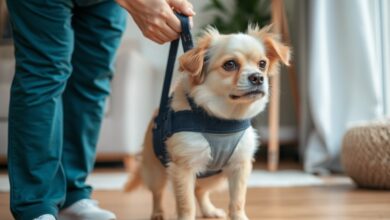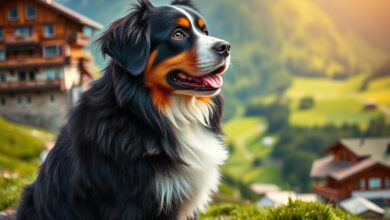How Great Is Your Dane: A Guide to Caring for Your Great Dane
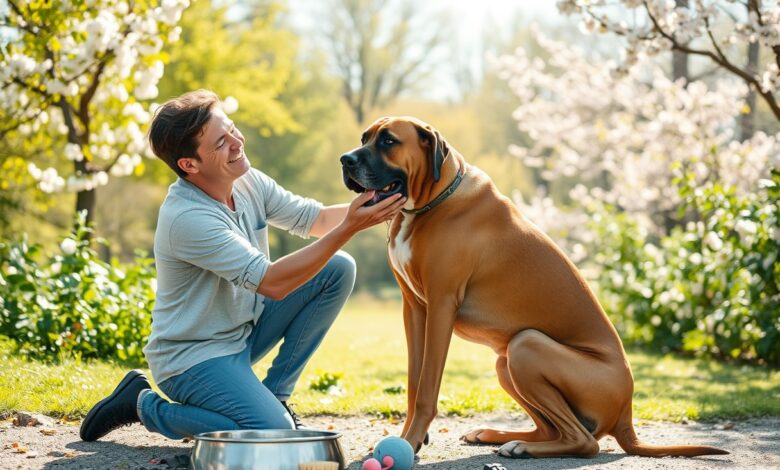
Great Danes are not just impressive in stature; they are also remarkable companions that require special attention and care. As their owner, you should be aware of their unique health needs, nutritional requirements, and the importance of regular exercise. This guide will help you navigate the responsibilities of caring for your Great Dane, ensuring they lead a happy, healthy life while fitting comfortably into your family and lifestyle.
Understanding the Great Dane
To truly care for your Great Dane, it’s vital to understand their history, physical characteristics, and temperament. Knowing where they come from and what makes them unique enables you to provide a loving and suitable environment for these gentle giants.
History and Origin
With origins that trace back to ancient Rome and the mastiffs of the area, Great Danes were originally bred for hunting large game such as deer and boar. Over time, they transitioned into noble companions, earning the title of the “Apollo of dogs” due to their majestic appearance and calm demeanor.
Physical Characteristics
For Great Danes, size is a defining trait. Males typically stand between 30-34 inches tall at the shoulder, while females are slightly smaller at 28-32 inches. Weighing anywhere from 110 to 175 pounds, their large frame is complemented by a strong, muscular body, short coat, and a long neck, contributing to their regal poise.
Plus, their coat comes in various colors including fawn, brindle, blue, and black, which can have an impressive impact on their overall look. Despite their size, Great Danes are surprisingly agile and possess a graceful gait. Ensuring proper nutrition and exercise is crucial, as maintaining their health can help prevent common issues such as hip dysplasia and other orthopedic problems that accompany their size.
Temperament and Behavior
Understanding the temperament of your Great Dane is vital to fostering a loving relationship. Known for their gentle and friendly demeanor, they are often referred to as gentle giants who are protective of their family.
Characteristics of a Great Dane include their loyalty, affability, and intelligence, making them excellent companions. While they are typically good with children and other pets, early socialization is necessary to mitigate any protective instincts. Be aware that their sheer size can sometimes be intimidating, so it’s important to train them to be aware of their body and surroundings. With proper guidance and training, your Great Dane can truly thrive in a loving home!
Nutrition and Diet
If you’re the proud owner of a Great Dane, understanding their nutritional needs is crucial for promoting their health and longevity.
Essential Nutrients for Great Danes
The foundational nutrients your Great Dane needs include high-quality proteins, healthy fats, carbohydrates, vitamins, and minerals. It’s crucial to provide a balanced diet, focusing on large-breed-specific food that supports their unique growth patterns and energy levels.
Feeding Guidelines and Schedules
Schedules should involve feeding your Great Dane two to three meals per day, ensuring that you space them out to prevent bloat, a serious condition common in this breed.
Diet is key for your Great Dane’s overall well-being. Utilize measured portions and avoid free-feeding to help maintain a healthy weight. Furthermore, consider incorporating omega-3 fatty acids for skin health and joint support, as well as ensuring they have constant access to fresh water.
Common Dietary Concerns
Guidelines for feeding should take into account some common challenges, such as food intolerances, allergies, and the risk of bloat due to their large size. Pay attention to any signs of discomfort when trying new foods.
Concerns about your Great Dane’s diet can be addressed by being vigilant about their reactions to different foods and adjusting accordingly. Always consult with your veterinarian if you notice symptoms like vomiting or prolonged diarrhea, and remember that overweight Danes can face additional health problems. Ensuring a focused and tailored approach will keep your loyal companion in peak condition.
Exercise Requirements
Many Great Danes have energy levels that surprise their owners, making regular exercise vital for their overall health and happiness. These gentle giants require structured activity to maintain their physical condition, prevent obesity, and foster a calm demeanor at home. Engaging your Great Dane in various physical activities not only keeps them fit but also strengthens the bond between you and your furry friend.
Recommended Activities and Games
Games such as fetch, tug-of-war, or even a simple game of hide and seek can provide excellent mental and physical stimulation for your Great Dane. Your dog will enjoy participating in activities that challenge their intelligence while also allowing them to work off energy. Incorporating training sessions into playtime can create a meaningful and engaging experience for both you and your dog.
Daily Exercise Routine
Activities like long daily walks, jogging alongside you, or playing in a safely enclosed area are crucial for your Great Dane’s exercise routine. Aim for at least 30 to 60 minutes of activity each day, adjusting the intensity based on your dog’s age and fitness level. Remember that your Great Dane’s massive size means they require a balance of exercise to avoid stress on their joints, especially during their growth stages.
Signs of Overexertion
The signs of overexertion in your Great Dane can manifest in various ways, including excessive panting, drooling, or lethargy. Keep an eye out for any discomfort or refusal to continue playing, as these can indicate that your dog has reached its limit. If you notice these signs, it’s crucial to allow your dog to rest and hydrate properly.
Signs of overexertion can lead to more serious health issues if ignored. Pay close attention to your dog’s behavior during and after exercise. If they experience uncontrolled panting, abnormal drooling, or a sudden lack of energy, this could indicate overheating or fatigue. Always provide plenty of water and a cool place for your Great Dane to recover after exercise, ensuring their well-being remains your top priority.
Health Considerations
Once again, understanding the health needs of your Great Dane is crucial for ensuring their quality of life. These gentle giants are prone to specific health issues that require your attention and proactive management. By being aware of these conditions and implementing the right care measures, you can help your canine companion live a long, healthy life.
Common Health Issues in Great Danes
Issues that commonly affect Great Danes include hip dysplasia, bloat, and cardiac problems. Their large size makes them susceptible to these ailments, which can lead to serious health complications if not properly addressed. Regular monitoring for symptoms and prompt veterinary attention can make a significant difference in your dog’s health outcomes.
Regular Veterinary Check-ups
An imperative part of caring for your Great Dane involves scheduling regular veterinary check-ups. These visits allow your vet to monitor your dog’s overall health, catch potential issues early, and provide necessary vaccinations.
Considerations during these visits should include an assessment of your dog’s weight, heart health, and any signs of joint pain or discomfort. Your vet can also advise on dietary needs and exercise routines tailored specifically for your Great Dane’s size, ensuring they receive proper care throughout their life. Regular vet check-ups are a vital preventive measure to keep your Great Dane thriving.
Preventive Care Measures
Issues with preventive care can lead to serious health risks for your Great Dane. It’s imperative to keep up with vaccinations, parasite control, and a balanced diet to maintain their health and prevent severe illnesses.
A proactive approach to preventive care includes implementing a tailored diet rich in necessary nutrients, ensuring regular exercise to maintain a healthy weight, and using medications to prevent heartworm and fleas. By establishing a routine that encompasses these measures, you can significantly reduce the likelihood of serious health problems in your Great Dane and enhance their quality of life. Note, a little effort goes a long way in ensuring your pet’s well-being!
Grooming and Hygiene
Not only do Great Danes have a majestic presence, but their grooming and hygiene are vital for their overall health and happiness. Maintaining a regular grooming routine not only helps keep your dog looking its best, but also prevents potential health issues that may arise from neglect.
Grooming Tools and Techniques
Techniques for grooming your Great Dane should include using a rubber curry brush to remove loose hair and dirt, followed by a soft-bristle brush to smooth the coat. Regular brushing, ideally once a week, keeps your dog’s coat healthy and shiny while minimizing shedding.
Bathing and Skin Care
Skin care is crucial for your Great Dane’s health, primarily because their skin can be prone to certain issues. Use a gentle, hypoallergenic dog shampoo specifically designed for your dog’s needs, and aim to bathe them every two to three months, or as necessary if they get dirty or smelly. After bathing, ensure you thoroughly dry your dog, especially in the folds of their skin, to prevent irritation.
Dental Care and Oral Hygiene
Any dog owner knows that proper dental care is vital for your Great Dane’s health. Regular brushing of their teeth is a must, ideally every other day, using a toothpaste formulated for dogs. Additionally, consider incorporating dental chews to help reduce plaque and tartar.
Oral hygiene is vital as it helps prevent serious conditions such as periodontal disease, which can lead to pain and tooth loss. Keep an eye out for signs of dental issues, such as bad breath or difficulty eating, and schedule regular veterinary check-ups to monitor your dog’s dental health.
Training Techniques
After bringing your Great Dane home, understanding effective training techniques is crucial for fostering a well-behaved and happy companion. Proper training not only strengthens your bond but also ensures that your dog is comfortable in various situations.
Basic Obedience Training
Basic obedience training is important for your Great Dane’s development. Start with simple commands like “sit,” “stay,” and “come.” Using positive reinforcement, such as treats and praise, encourages your dog to repeat desired behaviors. Consistency is key, so practice regularly to reinforce these fundamental commands.
Socialization with People and Other Pets
People and other pets can significantly influence your Great Dane’s behavior. It’s vital to introduce your dog to various environments, experiences, and different breeds early on.
This exposure helps your Great Dane become confident and reduce the risk of fear-based aggression. Attend puppy classes or arrange playdates, ensuring these interactions are positive. Note, well-socialized dogs are typically more well-adjusted and less anxious, making them easier companions in social settings.
Behavioral Issues and Solutions
People often encounter behavioral challenges with their Great Danes, such as excessive barking or jumping. Address these issues early to prevent them from becoming ingrained habits.
For instance, if your Dane displays excessive barking, it may be due to boredom or anxiety. Implement an engaging routine that includes regular exercise and mental stimulation. If jumping is an issue, teach the “off” command and reinforce it with consistent rules. Note, patience and consistency in your approach will yield the best results, ensuring your Great Dane grows into a respectful and well-behaved companion.
Creating a Safe Environment
Your Great Dane deserves a home that prioritizes their safety and well-being. Creating a secure environment for your giant companion involves addressing potential hazards both indoors and outdoors. By knowing the right precautions to take, you can enjoy a happy life with your beloved Dane, free from unnecessary risks.
Indoor Safety Precautions
One of the first steps you should take is to ensure your home is free of any potential hazards. Keep toxic substances, including cleaning supplies and electrical cords, out of reach. Secure heavy furniture that could tip over and monitor small items they might ingest. Create a comfortable space for your Dane to rest, away from heavy foot traffic.
Outdoor Safety Measures
To keep your Great Dane safe outside, always supervise their playtime and ensure your yard is securely fenced. A sturdy fence can prevent them from wandering off, while marking boundaries helps manage their size and strength. Make sure to remove any hazardous plants from your garden as well, as some can be poisonous to dogs.
It is also crucial to regularly check your yard for hidden dangers, such as sharp objects or chemicals that may be left behind. Using a leash when taking your Dane for walks not only keeps them safe from vehicles but also allows you to control their interactions with other animals. Ensuring your Great Dane always wears a collar with an ID tag can make a significant difference should they ever get lost.
Pet-proofing Your Home
To effectively pet-proof your house, ensure that all dangerous items are stored securely. This includes human foods that are harmful to dogs, such as chocolate or grapes, and items that could break and cause injury. When not in use, keep medications and sharp tools locked away to prevent accidents.
Understanding the importance of pet-proofing extends beyond just tidying up. It involves setting up a dedicated space for your Great Dane, removing obstacles that could lead to injuries, and considering furniture arrangements. For example, placing heavy items on lower shelves and securing large furniture can prevent tipping accidents. With these measures, you can significantly reduce risks, ensuring a more enjoyable and safe experience for both you and your Great Dane.
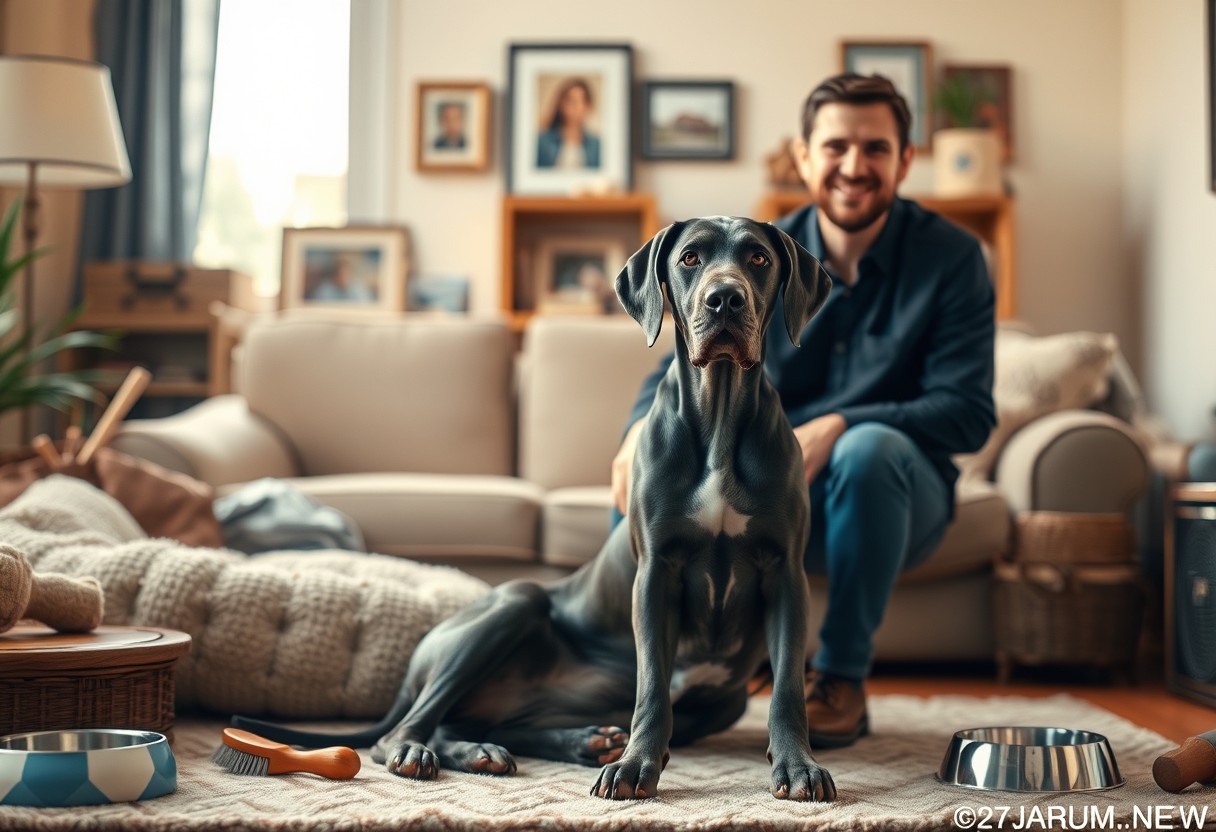
Great Dane Companionship
All dogs are pack animals by nature, and Great Danes are no exception. Their enormous size and gentle demeanor often mask their need for strong social interaction with humans and other pets. Understanding this need is crucial for fostering a happy and well-adjusted Great Dane. If left alone for long periods, they may experience anxiety or develop destructive behaviors.
Understanding Their Need for Social Interaction
On a fundamental level, Great Danes thrive on companionship. They best flourish when included in family activities and social settings, as this enhances their emotional well-being and strengthens their bond with you. Understanding this social need ensures that your Dane remains content and exhibits positive behavior.
Building a Strong Bond with Your Dog
Companionship is vital for Great Danes, and trust is the foundation of any relationship. Spending quality time together allows you to form a strong bond. Incorporate training, play, and simple interactions into your daily routine to deepen your connection.
With consistent interactions and positive reinforcement, your relationship with your Great Dane can become a source of mutual happiness. Regularly spending time together while engaging in training exercises or leisurely walks can further solidify your bond. A strong relationship can also ease any instances of anxiety or stress your dog may face, making them feel secure and loved.
Activities to Strengthen Your Relationship
Interaction with your Great Dane is vital for building a lasting relationship. Consider incorporating various activities that engage both their physical and mental capabilities, promoting a sense of fulfillment and closeness between you.
Social outings, such as trips to the dog park or participating in group training sessions, can help strengthen your bond. Activities like doga (dog yoga), hiking, or simply playing fetch can enhance the physical connection while providing mental challenges. Engaging in these activities not only promotes a healthy lifestyle for your Dane but also ensures that your companionship grows deeper over time.
Traveling with Your Great Dane
Once again, hitting the road with your Great Dane can be an enjoyable adventure, but it requires careful planning and consideration to ensure both you and your four-legged friend are comfortable and safe. Here’s how to make your trips with your Great Dane a success.
Preparation Before the Trip
Preparation is key when traveling with your Great Dane. Start by ensuring all necessary vaccinations are up to date and carry copies of health records. Invest in a comfortable and spacious travel kennel that allows your dog to move around easily. Plan frequent stops during the journey to give your Dane a chance to stretch, hydrate, and relieve themselves.
Safety Tips During Travel
Great Dane owners must prioritize safety while traveling. Always secure your dog in a harness or travel crate to prevent distractions while driving. Avoid letting your Dane stick their head out of the window, as it poses a risk of injury. Ensure your car is well-ventilated and maintain a comfortable temperature during your journey.
- Utilize a harness or travel crate
- Never allow your Dane to stick their head out the window
- Keep your vehicle at a comfortable temperature
Any situation that involves distracted driving can lead to accidents, so take extra precautions to keep your Great Dane safe.
A well-secured dog creates a smoother driving experience. Always double-check that the harness or crate is properly fastened before setting off. Use a dog seatbelt for additional security, and consider having a travel buddy who can monitor your dog while you focus on the road.
Dog-friendly Destinations
Before you hit the road, research and plan your stops at dog-friendly destinations. Look for parks, beaches, and accommodations that welcome large breeds like Great Danes. This ensures there are plenty of opportunities for exercise and play at your destinations.
Tips for finding dog-friendly locations include utilizing websites that specialize in pet-friendly travel options. Look for listings that mention large breeds and check reviews to gauge the experience of other dog owners. Some places even have special amenities for dogs, ensuring a delightful stay for both you and your Great Dane. Always call ahead to confirm policies regarding size restrictions and leash regulations.
Aging and Senior Care
For many Great Danes, aging is an inevitable process that can bring several physical and emotional changes. As a responsible owner, you need to be attuned to the signs of aging to provide the best care possible for your dog during these years.
Recognizing the Signs of Aging
Aging can manifest in various ways including decreased activity levels, stiffness in movement, changes in appetite, and weight fluctuations. You may notice your Great Dane having difficulty standing up or lying down, along with potential changes in behavior such as increased sleeping or irritability. Familiarize yourself with these signs to ensure you address any arising issues promptly.
Adjustments in Diet and Exercise
On the topic of diet and exercise, as Great Danes age, their nutritional needs evolve. You may need to transition your dog to a diet specifically formulated for senior dogs, which often has lower calories and added joint-supportive ingredients. Ensure that you keep their activity light but consistent to maintain a healthy weight, while also avoiding excessive strain on their joints.
The right balance of nutrients and exercise is crucial for the overall well-being of your senior Great Dane. Incorporating high-quality protein, healthy fats, and specific supplements can help manage their body weight and support their joint health. Consider daily short walks or swimming as great low-impact exercise options, allowing your dog to stay active without overexertion, making adjustments as needed based on their energy levels.
Health Care Needs for Senior Great Danes
The health care needs of senior Great Danes often differ from younger dogs. Regular veterinary check-ups become increasingly important for monitoring and managing specific health conditions. Be vigilant about any signs of discomfort, and discuss any changes you observe with your veterinarian.
Senior Great Danes typically require more frequent vet visits for screenings related to common age-related issues such as hip dysplasia, arthritis, and heart disease. Maintaining a comprehensive health care routine can include blood tests, dental check-ups, and recommended vaccinations, ensuring that your beloved pet leads a comfortable life as they enter their golden years. Keep in mind, early detection of health issues can significantly improve your dog’s quality of life.
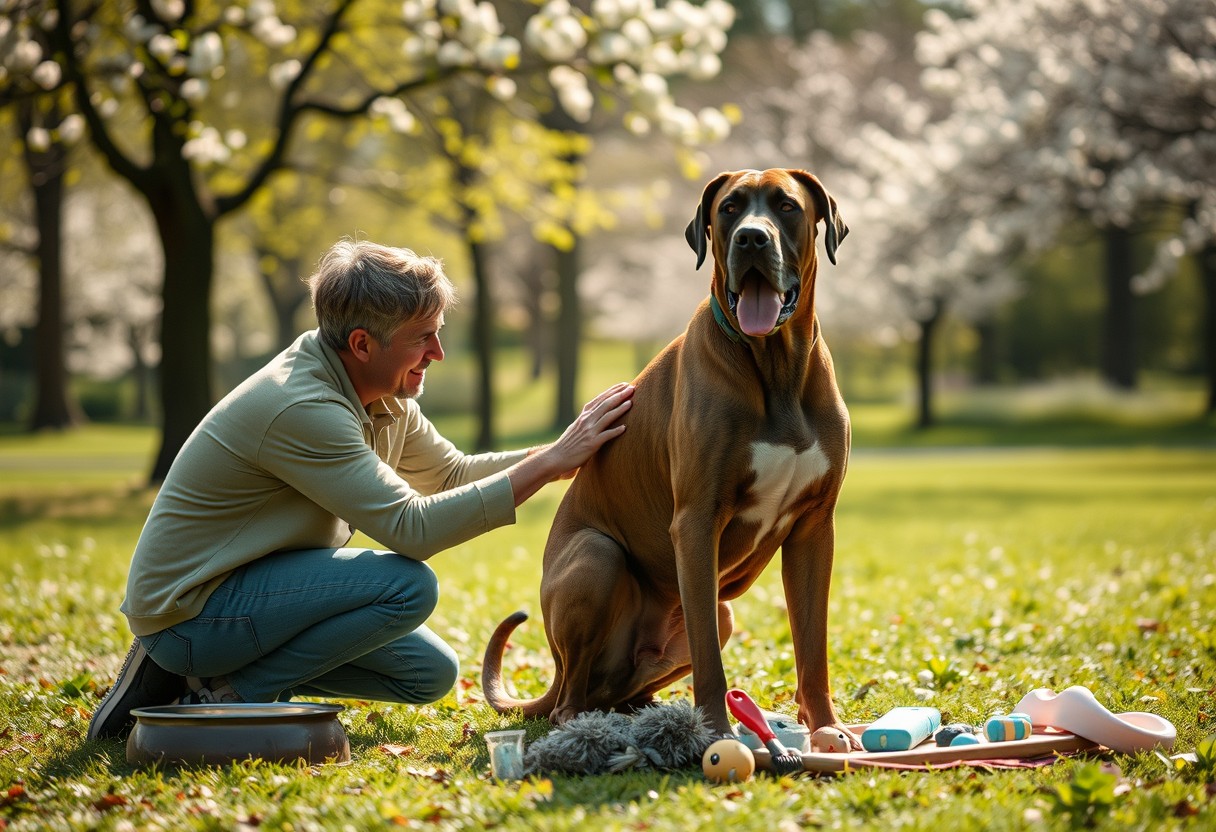
Common Myths and Misconceptions
Unlike many beliefs about their size and temperament, Great Danes are often misunderstood. You may hear claims about their behavior and lifestyle that simply aren’t true. Addressing these myths is necessary to provide a realistic view of this gentle giant and ensure you are fully prepared to give your Great Dane the best care possible.
Debunking Myths about Great Danes
Common myths suggest that Great Danes are aggressive and untrainable due to their size. In reality, they are known for their friendly nature and typically get along well with children and other pets. With proper training and socialization, your Great Dane can thrive as a well-behaved member of your family.
Understanding Their True Nature
Danes may appear intimidating at first glance, but they are actually one of the most affectionate dog breeds you can have. Their large size belies a gentle demeanor, making them great companions. They crave human interaction and loyalty, often forming strong bonds with their families. You might find your Great Dane to be surprisingly playful and protective, showcasing the best traits of a family dog.
Enhancing Awareness and Education
Awareness of the realities surrounding Great Danes is vital for current and prospective owners. Many people underestimate the care needed for such a large breed. By educating yourself and others about their specific requirements, you can help combat misconceptions and promote responsible pet ownership.
The responsibility of understanding your Great Dane extends beyond simple care; it involves fostering an environment that highlights their loving nature while addressing their physical and emotional needs. Staying informed and sharing knowledge with fellow dog enthusiasts can lead to a more positive experience for both you and your Great Dane.
Adopting a Great Dane
Keep in mind that bringing a Great Dane into your home requires thoughtful consideration and preparation. These magnificent dogs are not just big in size, but also in personality and commitment. You need to ensure that you are fully prepared for the love and care they require.
Choosing the Right Breeder or Shelter
Breeder selection is crucial when adopting a Great Dane. Look for reputable breeders who prioritize the health and temperament of their dogs. Ask about health screenings for common genetic issues and seek out breeders who are willing to share references. Alternatively, consider adopting from a shelter or rescue organization dedicated to Great Danes; this can be a fulfilling option that gives a dog in need a second chance.
Preparing Your Home for a New Dog
Any Great Dane will need a welcoming and safe space in your home. Begin by dog-proofing your environment – this means removing any hazardous items or delicate furniture that could be easily damaged. Additionally, ensure you have a comfortable bed, adequate food and water supplies, and enough space for your new giant to move around.
Great Danes, being large and somewhat clumsy in their movements, require a clear floor space to avoid accidents. You may want to designate a specific area for their bed and toys. It’s also wise to have some sturdy chew toys on hand, as they can be prone to boredom. Keep in mind, these dogs thrive on companionship, so creating a cozy, inviting environment will help ease their transition into your home.
The First Days with Your New Great Dane
First impressions matter, especially during the first few days with your new Great Dane. Introduce them gradually to your home, allowing them to explore while keeping a close eye on their behavior. Patience is imperative as your dog becomes familiar with their new surroundings.
Shelter your newly adopted Great Dane from overwhelming stimuli during the initial days. Give them time to adjust and establish a routine, which will help them feel secure and comfortable. Take walks in quiet areas to avoid overwhelming them with new sights and sounds, and ensure you have a safe, relaxing spot for them to retreat to if they feel anxious. Keep in mind, building trust through consistency and gentle interaction is key to a positive start for both you and your new furry family member.
Community and Support
Despite the challenges of caring for a Great Dane, you are not alone. Building a network of support can greatly enhance your experience and provide valuable resources for you and your beloved companion. Connecting with fellow Great Dane owners can offer insights, encouragement, and a sense of belonging within the community.
Finding Local Great Dane Groups
Support from local Great Dane groups can be invaluable as you navigate the unique needs of your dog. Connecting with these groups allows you to share experiences, gain tips on care, and even arrange playdates for your Dane. Search for breed-specific meetups or community organizations in your area that celebrate the Great Dane breed.
Online Resources and Forums
Community forums and social media groups dedicated to Great Danes can provide a wealth of information. **Engaging with other owners online** helps you stay updated on health tips, training advice, and shared experiences. It’s a great way to find solutions to challenges you might face while enjoying the camaraderie of fellow enthusiasts.
Understanding the ins and outs of Great Dane care can be simplified through these resources. Many forums feature subtopics on specific issues such as **diet, training, and health concerns**. You can ask questions and receive answers from knowledgeable members who have faced similar challenges, ensuring that you are well-informed and confident in caring for your Dane.
Participating in Great Dane Events
Resources for participating in Great Dane events are plentiful and can greatly enrich your experience with your dog. These events may range from fun days at the park to breed-specific shows or educational seminars. Engaging in these activities provides not just socialization for your Dane, but also an opportunity for you to learn from seasoned Dane owners.
Another way to bond with your Great Dane and the community is through participation in events. **These gatherings can enhance your dog’s social skills**, foster new friendships, and expose you to new training techniques and health topics. Look out for local event schedules, as they often feature opportunities to interact with expert trainers and veterinarians, allowing you to gain valuable knowledge in a fun and engaging environment.
Final Words
Upon reflecting on your journey with your Great Dane, it’s clear that understanding their unique needs is crucial for their happiness and well-being. Caring for such a majestic breed involves dedication, proper nutrition, regular exercise, and ongoing veterinary care. By following the guidelines outlined in ‘How Great Is Your Dane: A Guide to Caring for Your Great Dane’, you can ensure that your beloved companion leads a healthy, fulfilling life. Embrace the joy and responsibility of being a Great Dane owner, and your bond will undoubtedly flourish.
FAQ
Q: What are the basic care requirements for a Great Dane?
A: Great Danes are large dogs that require specific care to ensure their well-being. Their basic care requirements include a balanced diet that supports their size, regular exercise to maintain a healthy weight, and routine veterinary check-ups to monitor for common health issues. Additionally, due to their size, they can be prone to joint problems, so providing them with a comfortable space to rest and proper supplements can be beneficial. Socialization and training from an early age are also important to ensure they develop good behavior and become well-adjusted pets.
Q: How much exercise does a Great Dane need?
A: Great Danes need a moderate amount of exercise, typically around 30-60 minutes per day, depending on their age and health status. This exercise can include walks, play sessions, and some time in a securely fenced yard. It’s important to avoid excessive exercise or intense activities in extreme temperatures, as their size can make them more susceptible to heat-related issues. Mental stimulation is also crucial, so incorporating training sessions or interactive toys can help keep them engaged.
Q: What should I know about feeding my Great Dane?
A: Feeding a Great Dane requires careful consideration due to their rapid growth and larger size. It is important to choose a high-quality, large-breed dog food that meets their nutritional needs. Feeding should be divided into two to three meals per day to prevent gastric torsion, which Great Danes are prone to. Always ensure fresh water is available, and consult with your veterinarian for specific dietary recommendations and portion sizes tailored to your Great Dane’s age, weight, and activity level.



